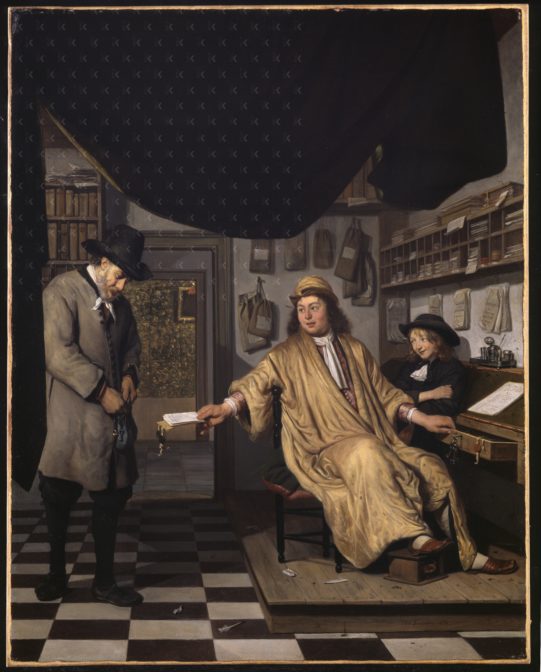Notarial records are some of the richest sources of information about our ancestors’ lives. They may contain wills, estate inventories, contracts, sales, and a range of other voluntary legal transactions. They are an important source for researching emigrants from the Netherlands. Many people went by a notary before leaving, for example to enter into a work contract or give a power of attorney to handle their affairs. Emigrants can still appear in notarial records after departure, if they owned or inherited property. Unfortunately, notarial records are underused since many people do not know how to find them.
Here are ten different methods to find out if your ancestors appeared in notarial records. Different places will require different methods, depending on how the archives (or volunteers) chose to make the records accessible.

Public notary in his office. Credits: Job Berckheyde, collection RKD.
1. Online index
Some archives or volunteers have entered the information from notarial records in a database and made that searchable. For example, at Alle Friezen, you can search for notarial records in Friesland since the early 1800s. Many of these indexed records are also available via national search engines like Open Archives or WieWasWie.
2. Online abstracts
Some archives have chosen to create abstracts of notarial records. For example, the Rotterdam City Archives have a search engine on their website to search the abstracts of Rotterdam notarial records. These abstracts contain names of people that you can search (alle velden = all fields). These abstracts will not be found if you use the specific people search forms on the website, since they are not indexed by first and last name, only full-text.
3. Transcriptions
In some cases, you can find complete transcriptions of notarial records online. This will increasingly be the case, as archives are using handwritten text recognition technology to automatically transcribe records. For example, automatically transcribed notarial records of Oosterhout, Terheijden, and Chaam are available via Verleden Tekst. Several North Holland and Utrecht wills are available via Zoek in Transcripties. Amsterdam notarial records are searchable via Transkribus.
5. Contemporary index by the notary
In many cases, the notary himself [it was always a “him” until the late 1900s] created an index, usually on either first or last name. This index can typically be found in the back or front of the register, but sometimes exists as a separate register called “repertorium.” Sometimes the archival description in the finding aid will mention that there is an index.

Office of the notary. Jan Woutersz. Stap, ca. 1629. Credits: Rijksmuseum
6. Card catalogs
Before the internet existed, archives often indexed notarial records on index cards. These card catalogs would line the walls of the reading room. In most cases, the physical card catalogs have been removed. The contents have either been entered into databases, or the cards themselves have been scanned and made available online. For example, the The Hague City Archives have scanned the indexes of persons and made those available in the finding aid of the notarial records.
7. Publications
Some people have published notarial records. This could be full transcriptions, abstracts, or indexes. You may be able to find these in libraries or the archives. In some cases, the publications have later become available online. An example is the series of indexes and abstracts created by G.H. Luiting of Winterswijk notarial records, available via GenealogieDomein.
8. Follow a reference
Sometimes, you may find a reference to a notarial records in another record. For example, a death duties file may mention a will, including the date and notary who registered it. Or a record of a sale may mention the date the property was first acquired and the notary that handled that purchase.
9. Infer a possible record
Some life events are likely to trigger the creation of a notarial record. For example, depending on the time, location, and social status, a couple may have created a prenuptial agreement. If you know when they married, you can check for a prenuptial agreement in the month before their marriage.
10. Browse the records
If all the above methods fail, you can always try turning the pages, either digitally (online scans) or physically (in the reading room).
Increasingly, archives are scanning notarial records. You will find them on the website of the archives that keep the originals, via the finding aids. For example, search for the term “notar*” in the website Archieven.nl will give you thousands of hits, including many finding aids of notarial records.
Some archives provide free scanning-on-demand so you can request scans that are not available yet. If the archive does not offer scans, you will have to go to the reading room.
Browsing records can be tedious, with low chance of success, especially in a large city. This is something I do when I have exhausted all the other options.
Tip: Digital Resources Netherlands and Belgium
The website Digital Resources Netherlands and Belgium has links to many online notarial records, whether they are available as scans, indexes, abstracts, or transcriptions.

